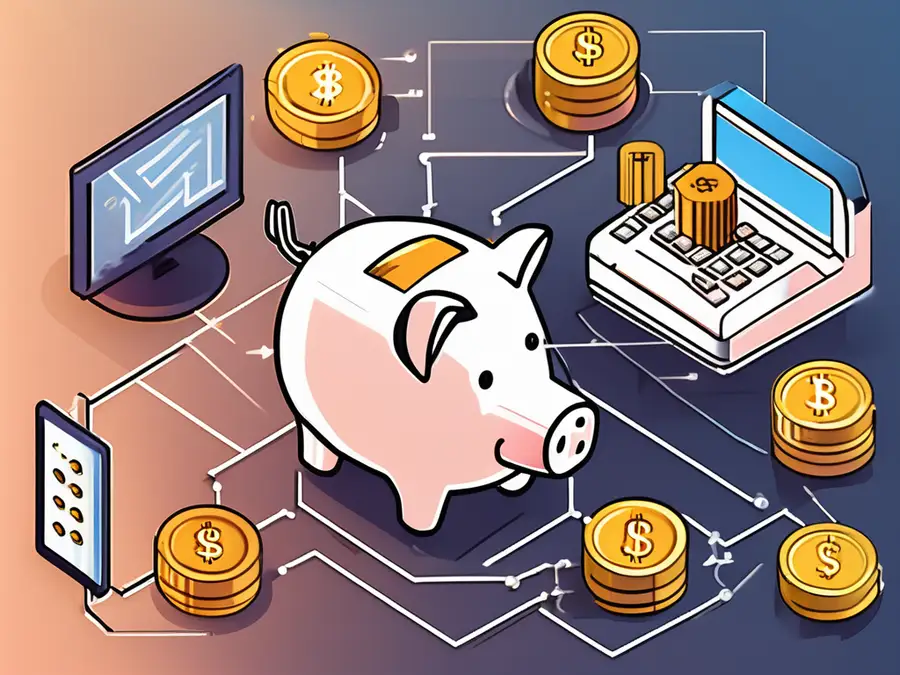A Guide to Understanding Blockchain Transaction Fees

Blockchain transaction fees are an essential aspect of the decentralized digital currency system. In this comprehensive guide, we will explore what blockchain transaction fees are, how they are determined, the different types of fees, how to calculate them, and techniques to minimize these fees. So, whether you are a crypto enthusiast, investor, or just curious about the technology behind digital currencies, this guide will provide you with valuable insights into blockchain transaction fees.
What are Blockchain Transaction Fees?
Blockchain transaction fees, simply put, are the charges incurred when you send or receive cryptocurrency on a blockchain network. These fees are an integral part of the system, as they serve multiple purposes. Firstly, they incentivize miners to process and verify transactions. Secondly, they help regulate the blockchain network and maintain its security and stability. Without transaction fees, bad actors could spam the network, causing congestion and delays. Therefore, transaction fees play a vital role in ensuring the smooth functioning of the blockchain ecosystem.
The Role of Transaction Fees in Blockchain Networks
Transaction fees are a fundamental part of the blockchain network's economic design. Miners, the individuals or entities responsible for verifying and adding transactions to the blockchain, prioritize transactions based on their fees. Higher fees incentivize miners to include transactions in blocks more quickly, ensuring faster confirmations. Additionally, transaction fees serve as a reward for miners, compensating them for their computational power and energy costs.
But what happens to the transaction fees once they are collected by the miners? Well, these fees become part of the miner's revenue. In addition to the block reward, which is a predetermined amount of cryptocurrency given to the miner for successfully mining a block, transaction fees contribute to their earnings. This dual incentive system ensures that miners have a vested interest in maintaining the integrity and security of the blockchain network.
Factors Determining the Cost of Transaction Fees
The cost of blockchain transaction fees varies depending on several factors. Firstly, the network's congestion level impacts the fees. During times of high demand, when many people are transacting, fees tend to rise due to increased competition for block space. Network congestion can occur during popular events or periods of intense market activity.
Another factor influencing transaction fees is the transaction size in bytes. Blockchain networks typically charge fees per byte, so more substantial transactions, such as those involving multiple inputs and outputs, will incur higher fees. This is because larger transactions require more computational power and storage space to process and verify.
Lastly, the urgency of the transaction also affects the fees. If you need your transaction to be confirmed quickly, you may opt to pay a higher fee to incentivize miners to prioritize it. This is particularly important for time-sensitive transactions, such as buying a limited-edition item or participating in a time-limited token sale.
The Process of Blockchain Transactions
Understanding how transactions are processed in the blockchain is crucial to comprehending transaction fees fully. When you initiate a transaction, it is broadcasted to the network and awaits confirmation. Miners collect pending transactions and package them into blocks. They then compete to solve complex mathematical puzzles to append the block to the blockchain.
How Transactions are Processed in Blockchain
Each block on the blockchain contains a limited amount of data. Miners select transactions to include in their blocks based on the fees attached to them. Therefore, transactions with higher fees are more likely to be included in the next block since miners have an incentive to prioritize them. Once a miner successfully solves the puzzle, the block is added to the blockchain, making the transactions within it confirmed and final.
The Role of Miners in Transaction Verification
Miners play a vital role in the transaction verification process. Their computational power and energy consumption secure the network and validate transactions. Miners are rewarded with newly minted cryptocurrencies and transaction fees for their work. This economic incentive motivates them to participate in maintaining the blockchain's integrity and processing transactions in an unbiased manner.
Different Types of Blockchain Transaction Fees
Blockchain networks feature different types of transaction fees. Understanding these distinctions will give you a comprehensive understanding of the fee structure and aid you in making informed decisions when transacting.
Fixed Transaction Fees
Some blockchain networks implement fixed transaction fees. These fees remain constant, regardless of the transaction size or network conditions. Fixed fees provide stability and predictability for users, enabling them to estimate costs accurately. However, during times of high congestion, fixed fees might result in slower transaction confirmations compared to networks with dynamic fee structures.
Dynamic Transaction Fees
Dynamic transaction fees fluctuate based on various factors, primarily network conditions and congestion levels. Blockchain networks utilizing dynamic fees adjust the transaction costs according to the demand for block space. During periods of heavy network traffic, fees rise to incentivize miners to prioritize transactions. Conversely, when network congestion subsides, fees tend to decrease. Dynamic fees offer flexibility and faster confirmations during peak usage.
How to Calculate Blockchain Transaction Fees
Calculating transaction fees in blockchain networks can be a complex task, especially for those new to the technology. However, understanding the fee market and utilizing specialized tools can simplify the process.
Understanding the Fee Market
The fee market refers to the supply and demand dynamics surrounding transaction fees. During times of increased network usage, such as during popular events or market volatility, fees tend to rise due to higher competition for block space. Monitoring the fee market helps users estimate appropriate fees to ensure timely transaction confirmations.
Tools for Calculating Transaction Fees
Many tools are available to assist users in calculating transaction fees. These tools consider network conditions, transaction size, and desired confirmation time to provide accurate fee estimates. Websites and mobile applications provide real-time fee recommendations, taking the guesswork out of fee calculations and ensuring optimal transaction experience.
Ways to Minimize Blockchain Transaction Fees
While transaction fees are an integral part of the blockchain ecosystem, users can employ various strategies to minimize their costs and optimize their blockchain experience.
Off-Chain Transactions
Off-chain transactions refer to transactions that occur outside the main blockchain network. These transactions leverage layer-two solutions or sidechains to facilitate faster and cheaper transactions. By conducting transactions off-chain, users can avoid high fees and enjoy almost instant confirmations, making it an attractive option for frequent and micro-transactions.
Transaction Fee Batching
Transaction fee batching involves bundling multiple transactions into a single transaction. By consolidating several transactions into one, users can reduce the overall fee expenditure, as they only have to pay for one transaction's cost. Additionally, this technique helps alleviate network congestion by reducing the number of individual transactions competing for block space.
By following these techniques and staying informed about the fee market, users can minimize transaction fees while ensuring their transactions are processed quickly and efficiently.
Personal Advice: As an expert in blockchain technology, I highly recommend utilizing transaction fee calculation tools and monitoring the fee market closely. Staying informed about network conditions and employing cost-saving techniques such as off-chain transactions and batching will help you optimize your blockchain experience. With the right knowledge and strategies, you can navigate the world of blockchain transaction fees with confidence and efficiency.
FAQs
What are blockchain transaction fees?
Blockchain transaction fees are charges incurred when sending or receiving cryptocurrency on a blockchain network. These fees incentivize miners and help regulate the network's security and stability.
How are transaction fees determined?
Transaction fees are determined based on factors like network congestion, transaction size, and the urgency of the transaction. Higher fees incentivize miners to prioritize transactions.
What are the different types of transaction fees?
Blockchain networks feature fixed transaction fees and dynamic transaction fees. Fixed fees remain constant, while dynamic fees fluctuate based on network conditions and congestion levels.
How can I calculate blockchain transaction fees?
Calculating transaction fees can be done using specialized tools that consider network conditions, transaction size, and desired confirmation time. These tools provide accurate fee estimates for optimal fee selection.
How can I minimize blockchain transaction fees?
To minimize transaction fees, you can explore off-chain transactions, which occur outside the main blockchain network, and transaction fee batching, which involves bundling multiple transactions into one. These techniques reduce costs and congestion.
Ready to take control of your trading experience without the burden of transaction fees? Morpher is your gateway to a revolutionary trading platform where you can trade stocks, cryptocurrencies, forex, and more with zero fees and infinite liquidity. Embrace the power of fractional investing, short selling, and up to 10x leverage to maximize your investment potential. With Morpher, you're not just trading; you're reshaping the future of investing. Sign Up and Get Your Free Sign Up Bonus today, and join the community of traders who are already navigating the markets with freedom and efficiency.

Disclaimer: All investments involve risk, and the past performance of a security, industry, sector, market, financial product, trading strategy, or individual’s trading does not guarantee future results or returns. Investors are fully responsible for any investment decisions they make. Such decisions should be based solely on an evaluation of their financial circumstances, investment objectives, risk tolerance, and liquidity needs. This post does not constitute investment advice.

Painless trading for everyone
Hundreds of markets all in one place - Apple, Bitcoin, Gold, Watches, NFTs, Sneakers and so much more.

Painless trading for everyone
Hundreds of markets all in one place - Apple, Bitcoin, Gold, Watches, NFTs, Sneakers and so much more.









